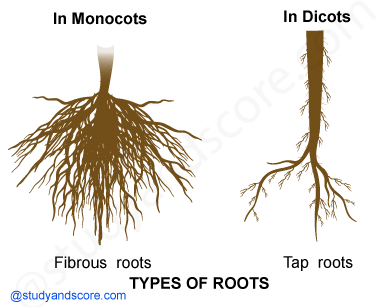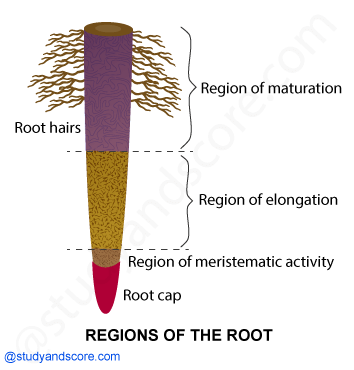Initially, the description of the life forms around us was made only through the study of external structures made by naked eye. Later as the technology progressed magnifying lenses and microscopes were developed. So the study of internal structures was made possible. And hence, the life forms were studied in more detail.
External structure or morphology is a very important characteristic of plants as it forms the basis for classification. Plants can be classified based on the morphological characters. Any given plant in general as roots, stems, leaves, flowers and fruits.
When a seed germinates, the radicle of the embryo comes out. The radicle of the embryo develops into first root or primary root. The primary root gives rise to other roots called secondary roots or lateral roots. Finally lateral roots give rise to tertiary roots.
The arrangement of the secondary roots on the primary roots and the arrangement of the tertiary roots on the secondary roots are in acropetal manner. This elaborate organization of all the roots of the plant is called as root system. The root system covers large volume of the soil.
Root is the underground main axis of the plant body which generally grows downwards into the soil. It initially fixes the seedling into the ground. Originally in majority of the dicotyledonous plants primary root is the direct elongation the radicle of the embryo.
| Root Cap | Root pocket |
|---|---|
| Present in all non-aquatic plants | Present only in aquatic plants |
| It is a tightly fitting structure | It is aloosely fitting structure |
| It can be regenerated | It cannot be regenerated |
Mainly there are two types of roots in angiosperms namely, Tap root system and fibrous root system. Let us discuss each of them.
Tap root system
Fibrous root system

The seed starts the germination and develops into young plant. Radicle, plumule and cotyledons are the three basic parts of a young seed.
1. Radicle is the embryonic root.
2. Plumule is the embryonic shoot.
3. Colyledons are embryonic leaves.
Based on the number of cotyledons angiosperms can be of two types namely, Dicots or Monocots. Dicots have two cotyledons while monocots have a single cotyledon.
The main differences between plumule and radicle are,
| Plumule | Radicle |
|---|---|
| Plumule is the embryonic shoot. | Radicle is the embryonic root. |
| Plumule grows after the growth of radicle. | Radicle comes out first from the seed. |
| Plumule develops into the future shoot, which is the stem and the leaves of the plant. | Radicle develops into the future root of the plant. |
| Plumule grows upwards out of the soil. | Radicle grows downwards into the soil. |
| Plumule is less white than the radicle. | Radicle is more white than the plumule. |
| Plumule is capable of photosynthesizing in order to produce food for the growing embryonic plant. | Radicle is capable of absorbing water from the soil, which is required for the development of the embryonic plant. |
**Roots developing from the radicle are called as normal roots and the roots developing from any other part of the plant except radicle are called adventitious roots.
Generally any normal root will show the following functions:
Absorption: Roots absorb the water and minerals from the soil. Absorption is the physiological function.
Fixation: The roots fix the plants firmly into the ground. They provide a proper anchorage to the plant parts. Fixation is morphological function.
Storage: The roots also help in storing reserve food material. Storage is physiological function.
Synthesis: Roots help in the synthesis of plant growth regulators. This is also a physiological function
Conduction: The water and the minerals which are absorbed from the soil are conducted up to the shoot with the help of roots. Conduction is physiological function.
In some aquatic plants such as Hydrilla, the roots are not well developed because the plants can absorb water directly through the epidermis.
Some hydrophytes like Wolffia, Ceratophyllum and Utricularia are completely without roots. In these plants the leaves are modified into root like structures. Here true roots are absent.
A typical young dicotyledonous root shows the following regions.
Root cap region
Region of meristematic activity

Region of cell elongation
Region of maturation
Region of root hairs
Hope you have liked this post.
Please share it with your friends through below links.
All the very best from Team Studyandscore
“Study well, Score more…”
- Share with your friends! -
Login to post your comment here...
- or with social Account -